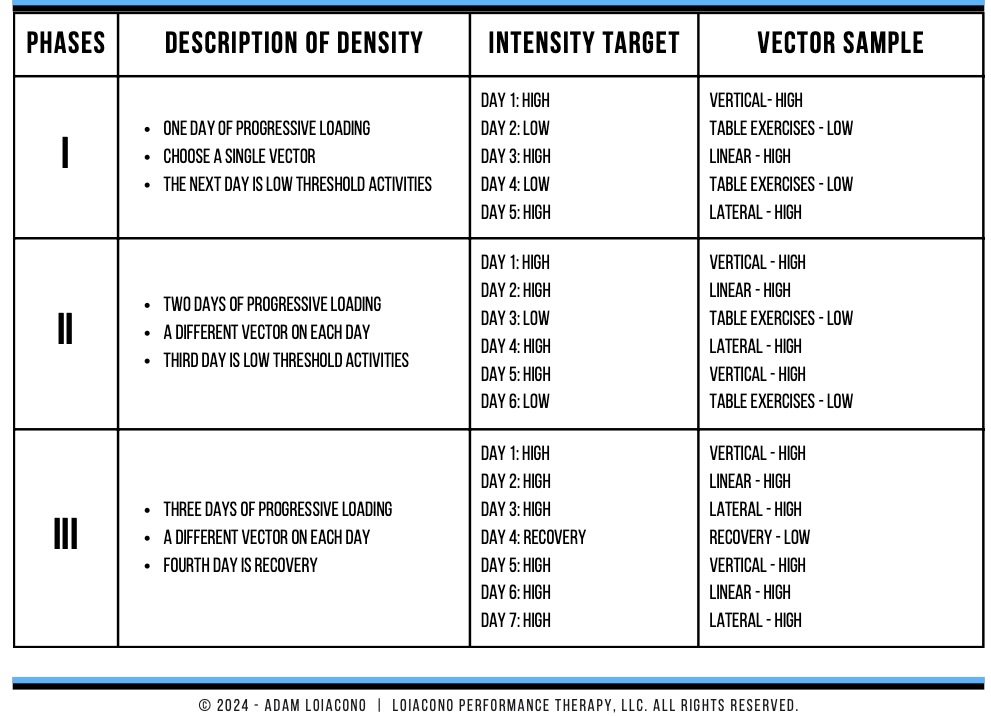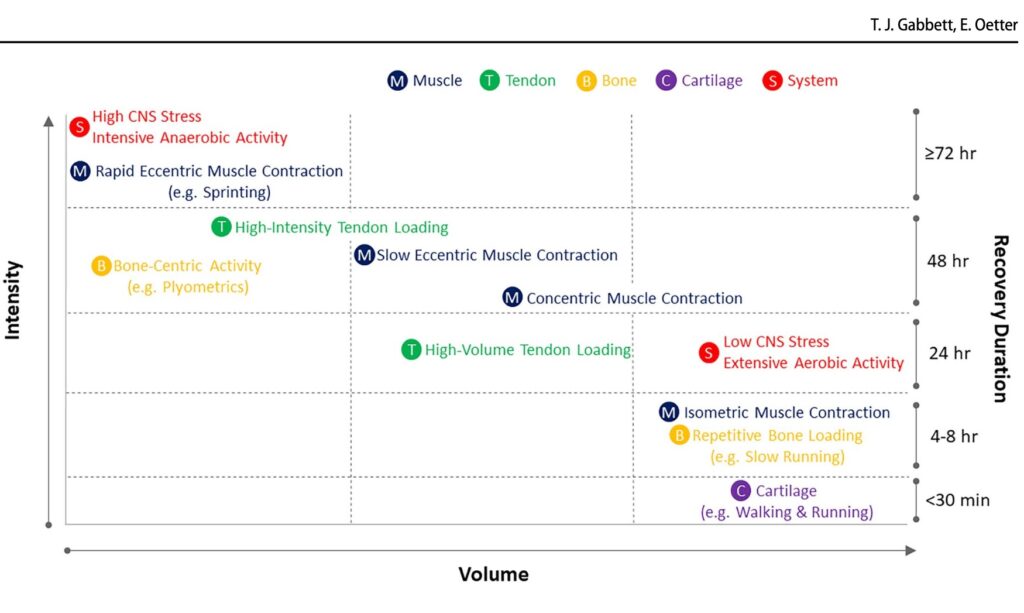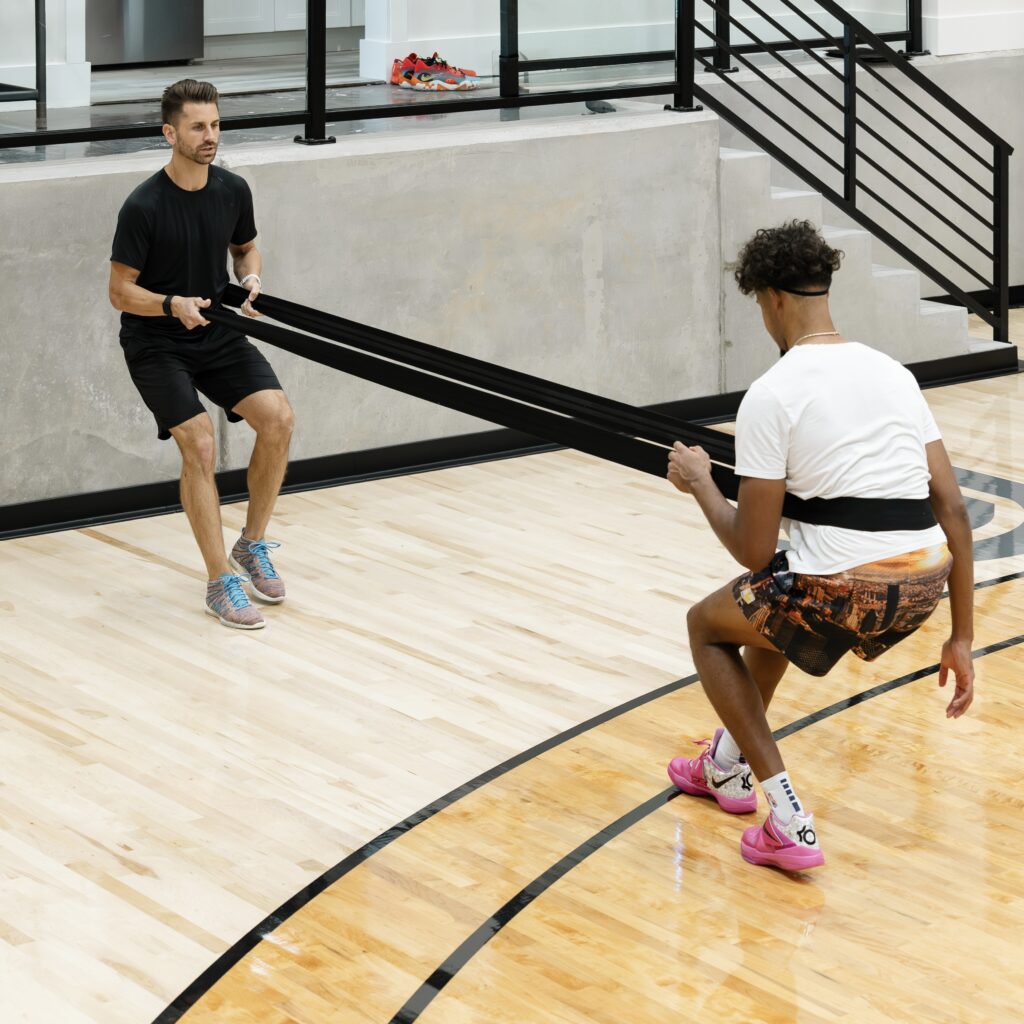Approximate Read Time: 12 minutes
“Progression in rehab isn’t just sets, reps, or load—it’s about the rhythm of stress and recovery across the weeks.”
What You will learn
- Why density matters more than sets and reps.
- How high/low day structure drives adaptation.
- Practical ways to apply density in rehab.
What Is Density in Rehab?
When therapists and coaches talk about progression, the conversation usually defaults to sets, reps, intensity, or volume. These variables matter—but they’re not the full picture. Real progression also depends on how stress is distributed across time. That’s where density comes in.
Density = Load × Frequency. Load itself is the product of volume × intensity, while frequency reflects the number of days stress is applied.
Strategically manipulating density allows a clinician or coach to push an athlete’s capacity while simultaneously protecting recovery. In practice, this looks like alternating high-intensity loading days with low-threshold recovery days. High days provide the necessary stimulus for adaptation. Low days allow tissues and the nervous system to consolidate those gains.

This concept aligns with the Training-Injury Prevention Paradox: both under-training and over-training raise risk, but a well-managed balance of workload reduces injuries and drives adaptation (Gabbett, 2016). Density is the lever that manages that balance.
Research on periodization reinforces this. Periodized programs—whether linear or undulating—consistently outperform non-periodized or monotonous approaches for building strength and durability (Williams et al., 2017; Moesgaard et al., 2022). Importantly, these models succeed not just by adjusting load, but by controlling the rhythm of stress and recovery across the week.
Why Medium Days Don’t Work
If high-intensity days provide the stress needed for adaptation, and low-threshold days provide recovery, then what about medium-intensity days? On paper, they seem like a safe compromise. In reality, I believe them to be a dead zone.
Medium days don’t generate enough stimulus to create meaningful adaptation, yet they’re still stressful enough to interfere with recovery. This is why your rehab week should oscillate clearly between high and low thresholds. The nervous system and tissues thrive on contrasts—stress followed by relief, effort followed by consolidation.
“Medium days feel safe, but they deliver too little to adapt and too much to recover.”
This principle echoes what periodization research has shown for decades: variation drives results. When programs fail to vary, progress stagnates or worse—injury risk climbs. Gabbett (2016) demonstrated that sudden spikes in training load, often caused by stacking medium-to-high days, significantly increase injury risk. By contrast, managing density with clear highs and lows prevents overload while still nudging adaptation forward.

Structuring Rehab Weeks With Density
Below further highlights how we can structure density within rehab, and even use density as a progression in of itself:
- Phase I: One day on, one day off.
A single high-intensity loading day followed by a low-threshold recovery day. This pattern builds tolerance and confidence early.
Example: High-intensity vertical loading on Day 1, table-based recovery exercises on Day 2. - Phase II: Two days on, one day off.
Two progressive high days, each targeting a different vector (vertical, linear, lateral), then one low-threshold day.
Example: Day 1 vertical, Day 2 linear, Day 3 recovery. - Phase III: Three days on, one day recovery.
High-intensity loading across three vectors, then a full recovery day. This phase mirrors competitive demands and requires higher resilience.
Example: Vertical → Linear → Lateral → Recovery.
This approach ensures density scales in both load and frequency. Athletes don’t just get stronger because they lift more or run harder—they adapt because the stress is distributed in a strategic rhythm.
These structures also echo findings from resistance training research: programs that manipulate volume, intensity, and frequency across days—what we call periodization—are superior to constant-loading programs (Rhea et al., 2002; Williams et al., 2017; Moesgaard et al., 2022). Rehab, when structured this way, becomes a miniature form of periodization.
Density and Undulating Periodization
When you zoom out, density in rehab is essentially a form of undulating periodization. Instead of progressing linearly by slowly increasing load week to week, undulation manipulates intensity and frequency across shorter time frames—sometimes daily (Rhea et al., 2002).
The same concept applies in rehab. A high day followed by a low day is undulation. Two highs followed by a recovery day is undulation. This back-and-forth pattern creates variation in stress that the neuromuscular system craves to adapt and avoid stagnation (Williams et al., 2017).
“Density is undulating periodization in disguise: it’s not about doing more, it’s about when you do it.”
Meta-analyses confirm this: periodized programs that vary stress, especially with daily or weekly undulations, consistently outperform non-periodized programs for strength development, even when training volume and intensity are equated (Moesgaard et al., 2022). In other words, it’s not just how much you do—it’s how it’s arranged.
Why Frequency and Variation Beat Monotony

Another way to look at density is through the lens of frequency. Increasing how often a stimulus is applied—without exceeding recovery capacity—amplifies adaptation. More frequent exposures spread across time create greater opportunities for motor learning, neural adaptation, and tissue remodeling (Williams et al., 2017).
This principle is especially relevant in rehab. A single “big” session once a week may look impressive, but spreading that same load across multiple exposures with alternating high/low thresholds provides superior results. This is why increasing density strategically can accelerate progress without overloading healing tissues.
The paradox is that more isn’t always better—smarter distribution is better. Gabbett (2016) described this balance in the training-injury paradox: athletes who gradually increase load through well-managed density adapt and stay healthier, while those exposed to random spikes or monotonous medium loads are more likely to get hurt.
Practical Examples for Clinicians
- Post-ACL Rehab: Early density might look like 1 high-load quadriceps session followed by 1 low-load neuromuscular control day, repeated across the week. As tolerance builds, clinicians can increase density to 2–3 high-load days separated by low-threshold days.
- Hamstring Strain Rehab: High days emphasize eccentric loading and sprint mechanics. Low days emphasize isometrics and trunk stability. Alternating these avoids overload while building readiness for sprint exposure.
- Return-to-Play Progression: Athletes moving toward late-stage rehab may tolerate 3 consecutive high days across different vectors (vertical, linear, lateral), followed by full recovery. This density mirrors competitive demands more closely.
Each of these examples demonstrates that density isn’t about more exercises or heavier weights—it’s about controlling the spacing and rhythm of stress and relief so adaptation happens without breaking the system.
Conclusion: Density as the Hidden Lever in Rehab
Rehab progression has always been described in terms of sets, reps, intensity, and volume. But what truly separates effective programs from ineffective ones is how these variables are distributed across time. That’s density.
“Progression in rehab isn’t just more weight or reps—it’s how you arrange the rhythm of stress and recovery.”
Here are the lessons to carry forward:
- Density = Load × Frequency. Load alone doesn’t define progress—spacing and rhythm matter.
- High + low beats medium. Medium days stall progress; contrasts drive adaptation.
- Density is undulating periodization in disguise. It’s not more stress, it’s smarter stress.
- Frequency and variation accelerate learning. Smaller, strategic exposures outperform random or monotonous programs.
- Managing density protects against injury. Avoiding spikes and monotony reduces risk while building resilience.
Think of density as the rhythm section in music. Sets, reps, and load are the melody, but without rhythm, the song falls apart. Similarly, rehab without density lacks the structure to create harmony between stress and recovery.
Free Download
Watch More Like This
Read More Like This
Related Podcasts
References
Gabbett TJ. The training-injury prevention paradox: should athletes be training smarter and harder? Br J Sports Med.2016;50(5):273-280. doi:10.1136/bjsports-2015-095788.
Rhea MR, Ball SD, Phillips WT, Burkett LN. A comparison of linear and daily undulating periodized programs with equated volume and intensity for strength. J Strength Cond Res. 2002;16(2):250-255.
Williams TD, Tolusso DV, Fedewa MV, Esco MR. Comparison of periodized and non-periodized resistance training on maximal strength: a meta-analysis. Sports Med. 2017;47(10):2083-2100.
Moesgaard L, Beck MM, Christiansen L, Aagaard P, Lundbye-Jensen J. Effects of resistance training periodization on strength and muscle hypertrophy in volume-equated programs: a systematic review and meta-analysis. Sports Med.2022;52(7):1547-1563. doi:10.1007/s40279-021-01636-1
Gabbett, T. J., & Oetter, E. (2024). From tissue to system: What constitutes an appropriate response to loading? Sports Medicine. Advance online publication.





